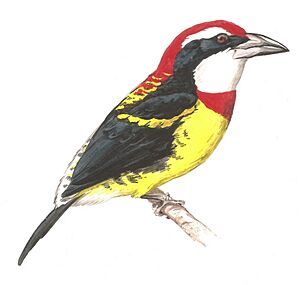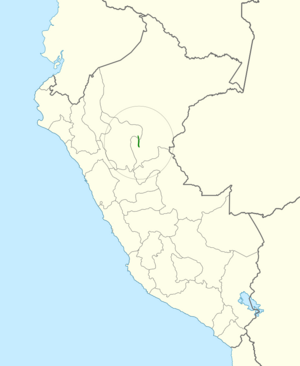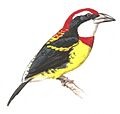Scarlet-banded barbet facts for kids
Quick facts for kids Scarlet-banded barbet |
|
|---|---|
 |
|
| Conservation status | |
| Scientific classification | |
| Genus: |
Capito
|
| Species: |
wallacei
|
 |
|
| Synonyms | |
|
Scarlet-belted barbet |
|
The scarlet-banded barbet (Capito wallacei) is a type of bird found in the New World barbet family, Capitonidae. This colorful bird lives only in Peru.
Contents
About the Scarlet-Banded Barbet
The scarlet-banded barbet was first discovered in 1996. Scientists officially described it in the year 2000. Most experts agree that it is a unique species. However, some groups think that the "Sira barbet" might be a subspecies of it.
What Does It Look Like?
This barbet is about 19.5 cm (7.7 in) long. It weighs between 65 to 78 g (2.3 to 2.8 oz). It has very bright colors!
- Its head and the back of its neck are bright red.
- A wide white stripe goes above its eyes.
- Its cheeks are black.
- Most of its back is black, but it has a yellow spot in the middle.
- It also has a large white patch on its rump (the lower back).
- Its throat and upper chest are white.
- Below that, there is a wide red band.
- The rest of its belly is yellow.
Where Does It Live?
The scarlet-banded barbet has only been found in one special place. This place is called Peak 1538. It's a ridgetop in the remote Cordillera Azul National Park in Peru.
This bird lives in humid, mossy forests. These forests are found on mountainsides. They are usually at high elevations. The barbet lives between 1,350 and 1,500 m (4,430 and 4,920 ft) above sea level.
How Does It Behave?
What Does It Eat?
The scarlet-banded barbet looks for food high up in the forest trees. It has been seen in small groups of its own kind. It also joins groups of different bird species looking for food together. This barbet eats fruits and seeds. It probably eats insects too.
Reproduction and Life Cycle
Scientists think the scarlet-banded barbet's nesting season is from March to May. This is based on birds studied in 1996. Not much else is known about how these birds raise their young.
What Does It Sound Like?
The scarlet-banded barbet has a unique song. It's a fast, low trill that sounds like a woodpecker drumming. You can hear it here: [1]. Its call is a rough, guttural sound. You can hear it here: [2].
Is It in Danger?
The IUCN (International Union for Conservation of Nature) says the scarlet-banded barbet is a "Vulnerable" species. This means it could become endangered if its situation doesn't improve. Even though it seems common in its small home, its living area is tiny. Experts believe there are fewer than 1000 of these birds left.
Images for kids




